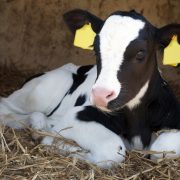Randomized controlled field trial comparing quarter and cow level selective dry cow treatment using the California Mastitis Test
Randomized controlled field trial comparing quarter and cow level selective dry cow treatment using the California Mastitis Test

Open access
In our edition of: Oct 2021
In our categories of: farm animals
our summary:
Swinkels, J.M. et al. (2021) Randomized controlled field trial comparing quarter and cow level selective dry cow treatment using the California Mastitis Test. Journal of Dairy Science, 104 (8), pp. 9063-9081.
The objective of this randomised controlled field study was to compare antibiotic use and dry period outcomes of selective cow level treatment (SCLT) and selective quarter level treatment (SQLT) in dairy herds in the United Kingdom, using the California Mastitis Test (CMT) to determine infection status at the quarter level at drying off (DO).
Six commercial farms in the southwest of England were selected to participate. Cows were randomly selected for inclusion in the study and categorised based on their somatic cell count (SCC) to either the high or low SCC group. Cows with individual SCC ≥200,000 cells/mL in any of the last three months or an occurrence of clinical mastitis (CM) within that period were categorized to the high SCC group. Within each of the two SCC categories, the cows were randomly allocated into one of three treatment groups. In one group, treatment was allocated at cow level (SCLT) where all quarters received the same treatment. In the other groups, antibiotic treatment was applied at quarter level (SQLT), according to a CMT score of either 1 (the SQLT1 group) or 2 (SQLT2) All cows received an internal teat sealant. Quarter milk samples were collected at DO and postcalving for SCC and bacteriological culture, cows were monitored for clinical mastitis from drying off until 100 days in milk.
From an enrolment of 807 cows at DO, data from 764 cows were available for analysis, of which 381 cows were categorised as high SCC and 383 cows as low SCC. Within the high SCC category, the number of cows for each of the three treatment groups were H-SCLT (126), H-SQLT1 (122), and H-SQLT2 (133) and in the low SCC category L-SCLT (125), L-SQLT1 (128), and L-SQLT2 (130).
There was no significant difference shown by high SCC cows in the apparent cure rates for major pathogens, although the apparent cure rates for minor mastitis pathogens was significantly lower in the H-SQLT2 group than in the H-SQLT1 or H-SCLT treatment groups. In the low SCC category, there was were no significant differences in apparent cure rates for major pathogens, though the apparent cure rate for minor coryneform mastitis pathogens was significantly lower in the L-SCLT group than in the L-SQLT1or L-SQLT2 treatment groups.
Looking at antibiotic (AB) usage in the high SCC group, the proportion of quarters treated with AB reduced from 100% at cow level (H-SCLT) to 69% (H-SQLT1) and 45% (H-SQLT2) at quarter level. In the low SCC cow category, the proportion of quarters treated with AB increases from 0% at cow level (L-SCLT) to 12% (L-SQLT2) and 31% (L-SQLT1) at quarter level.
Limitations of the study are the small number of herds from one geographical location and that the study could not be fully blinded with regards to product characteristics.
Results from the study suggest that on low SCC farms, antibiotic treatment at quarter level in cows with high SCC at dry off can result in a reduction in antibiotic use with only minor consequences for udder health.
Image copyright attribute: pressmaster
Join the discussion
We encourage discussion on all material highlighted in each edition of inFOCUS. Use the button below to join the conversation on Twitter and include your comment in the feed for this issue.






Leave a Reply
Want to join the discussion?Feel free to contribute!